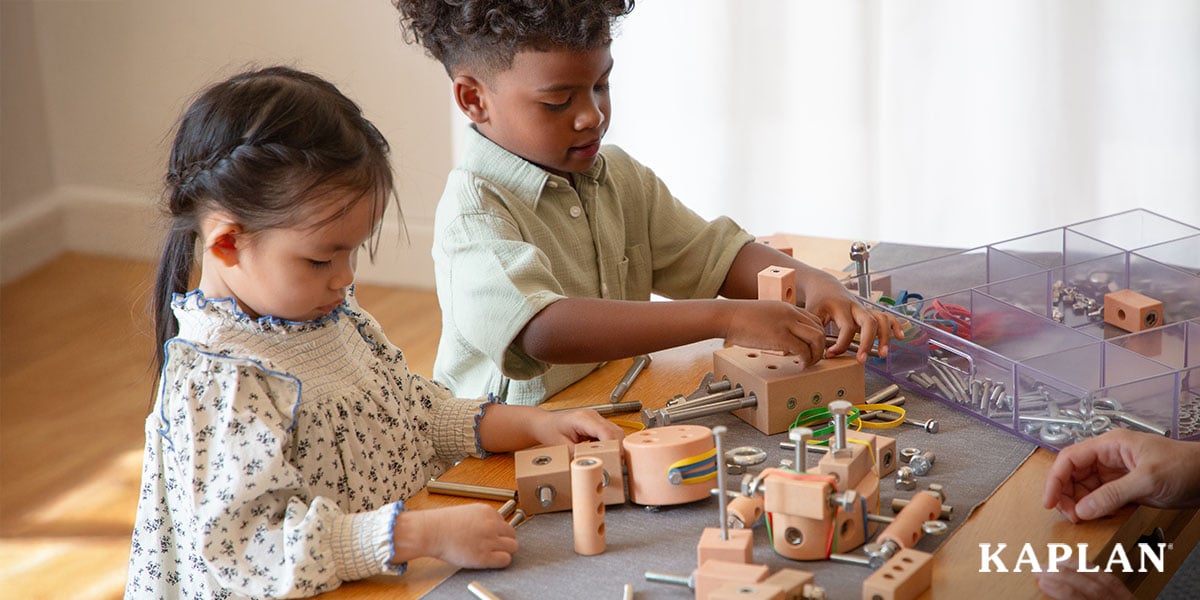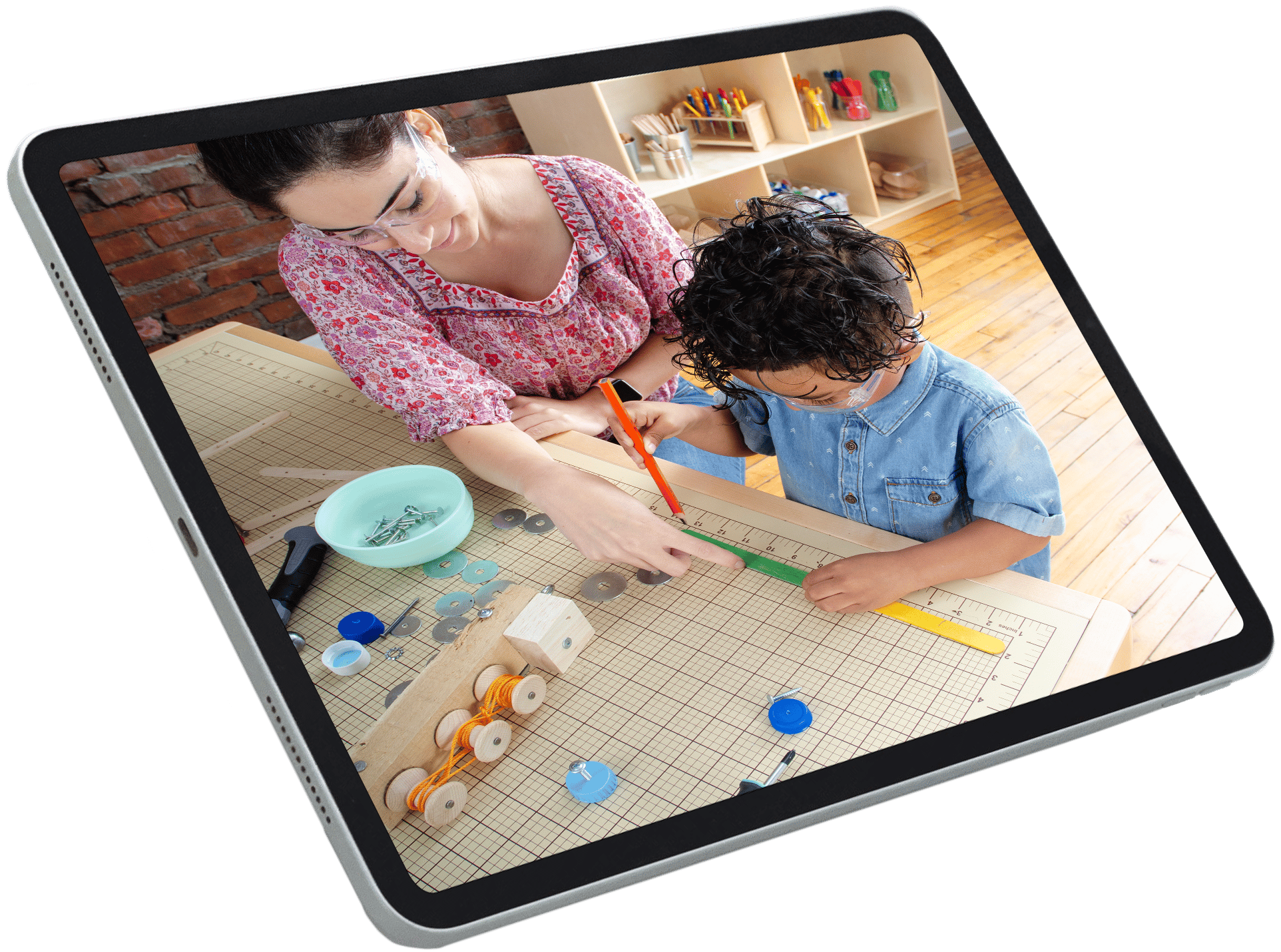Have you ever noticed children repeating actions and behaviors during play? This could be anything from filling and refilling a bag to rolling a toy back and forth across the room. These repetitive patterns of play are called play schemas, and they are what young children use to get a sense of the world around them.
If you want to give children educationally and developmentally rich play experiences, it is a great idea to provide open-ended materials that extend the play schemas already happening in the classroom. One solution that serves this purpose is loose parts. With loose parts materials such as acorns, buttons, and string, children can engage in open-ended play that develops skills such as fine motor coordination, creative thinking, and problem solving.
As you think about incorporating loose parts materials into your classroom learning centers, you may be wondering: What play schemas do loose parts support? How can I give children loose parts that will support their specific schemas? How can I engage children in productive loose parts play that supports their physical and cognitive development?
Drawing on the work of early childhood educator and author Michelle Thornhill, this article will walk you through typical play schemas you might see in your classroom and explain how you can use loose parts to reinforce natural play patterns and facilitate physical and cognitive development.
What are typical play schemas you might see in the early childhood classroom?
You have probably noticed that young children play in interesting ways. Some children take blocks and line them up in a row on the floor instead of stacking them on top of one another. Other children put a big pile of Legos in a basket and carry the basket back and forth across the room. Other children repeatedly pick up a ball and drop it.
All these behaviors are examples of play schemas. When children engage in these kinds of schematic play, they gain a deeper understanding of the world around them. Schematic play also introduces young children to concepts such as cause and effect, problem solving, and resilience.
- Connecting: joining items together, such as toy pieces of railroad track
- Trajectory: paying close attention to how things move; pouring water into a sink or throwing a ball
- Enclosing/enveloping: creating enclosed spaces (for example, putting items in a box and closing the lid); covering items using things like blankets and towels
- Dynamic vertical: creating vertical movement during play; dropping items repeatedly or building tall structures
- Rotation: twisting and turning objects; spinning the tires on a toy car or truck
- Going through a barrier: poking a hole in a piece of paper or putting an object in a hole
- Transporting: moving things from one place to another with either your hands or a carrier such as a basket
- Ordering/positioning: putting objects in a specific order or pattern such as smallest to largest
- Transformation: changing the form or appearance of something; switching outfits on a doll or painting an item a different color
- Dynamic horizontal: creating side-to-side movement; sliding objects across a table
- Orientation/perspective: looking at your surroundings from different viewpoints; using magnifying glasses or scaling playground climbers.
Because play schemas are an essential part of children’s play and development, your classroom should include materials that encourage them. Otherwise, children are likely to become bored and disinterested and may even behave disruptively if they cannot play in ways that interest and satisfy them.

How can you use loose parts to promote play schemas?
Because of their open-ended nature, loose parts are the perfect tool to enhance schematic play. With these materials and a few classroom staples, you can boost children’s cognitive and physical development. Here are a few examples of how you might use loose parts to promote the various play schemas we discussed earlier.
Enclosing/enveloping play schema
This play schema involves covering and hiding objects, emptying and filling containers, and creating spaces with clear boundaries. Children who may be exploring this schema love to do things like play hide and seek, build forts, or bury items in the sand.
To facilitate this type of play with loose parts, provide children with items they can use to cover or hide their loose parts, such as a cardboard box, a blanket, or a basket. Prompt the children to put some loose parts, such as buttons, beads, or jewels, in these containers so they can practice enclosing and enveloping. Another good option for encouraging this schema is our Sensory Surprise Tissue Box. The fabric cloth tissues that come with this box are perfect for covering objects.
Rotation play schema
Children who exhibit the rotation play schema love to make things twist and turn—whether that be twisting the knobs on a dramatic play kitchen or rolling balls down a ramp to crash them into a block castle.
If you want to encourage this pattern of play, provide children with loose parts they can spin, wind, or twist. Paper towel holders, balls, and spools of string are a few simple but effective options. Since some of the items may be small, please remember to keep safety at the forefront when choosing items for your classroom. Dr. Carla Gull, loose parts expert and coauthor of Loose Parts Learning in K-3 Classrooms and Loose Parts Alive: Inspiring Child-Led Nature Explorations, recommends using a choke tube to make sure none of your loose parts are a choking hazard if you have children under 3 years old in your classroom.
Kaplan’s Random Robots Loose Parts STEM Kit also gives children lots of opportunities to experiment with rotation. As children build and create, they will see how rotation works when they twist screws, nuts, and bolts into blocks to connect them together and give their robots bodily features such as eyes and ears. Please note that this kit has small parts, which are a choking hazard for children under the age of 3.

Transporting play schema
Children who love moving items from one place to another are exhibiting this play schema. These children tend to have their hands and/or pockets full of objects and may also love to fill a toy dump truck or shopping cart up with objects to move them from one play area to the next.
To foster this pattern of play, provide children with buckets, dump trucks, baskets, and other items that they can use to carry things. It is also important to make sure your loose parts area has plenty of items that are small enough for children to carry. There are lots of possibilities here, but a few quick examples are beads, buttons, and pom pom balls. Kaplan’s Timeless Treasures Loose Parts STEM Kit includes small items such as gemstones and coins and small bags that children can use to transport them.
To bring transportation to young children’s minds, put empty carriers and small items together in a center that will have small items such as a block center or manipulative center. You can also facilitate this schema outdoors. Give each child a bag or basket. Go on a nature walk and tell children to collect items they find along the way such as acorns and sticks. Have children bring the items back to your center and show a couple of them to their friends.
Want to incorporate loose parts play in your classroom?
If you want to bring loose parts play to your classroom but are not sure how, Kaplan can help. Visit our website to download a free PDF about developing a loose parts mindset from loose parts expert Dr. Carla Gull. No matter where you are on your loose parts journey, we want to partner with you to give children the best possible play and learning experiences. 

